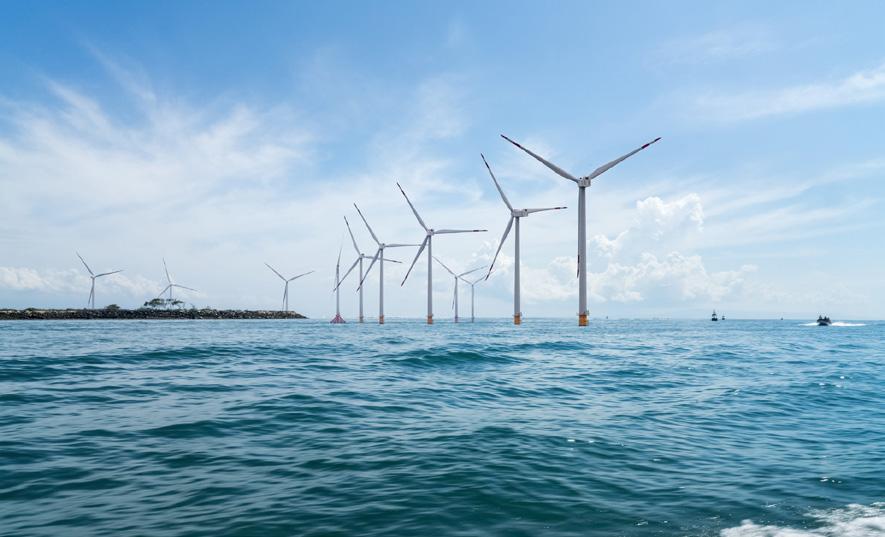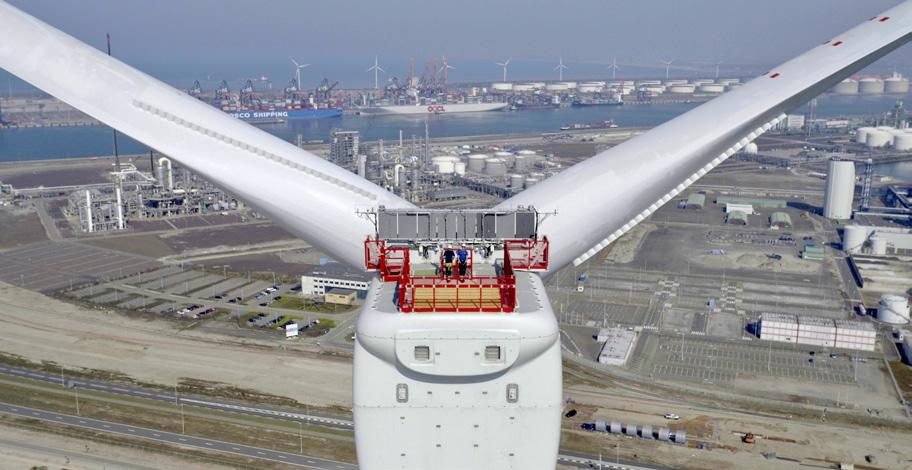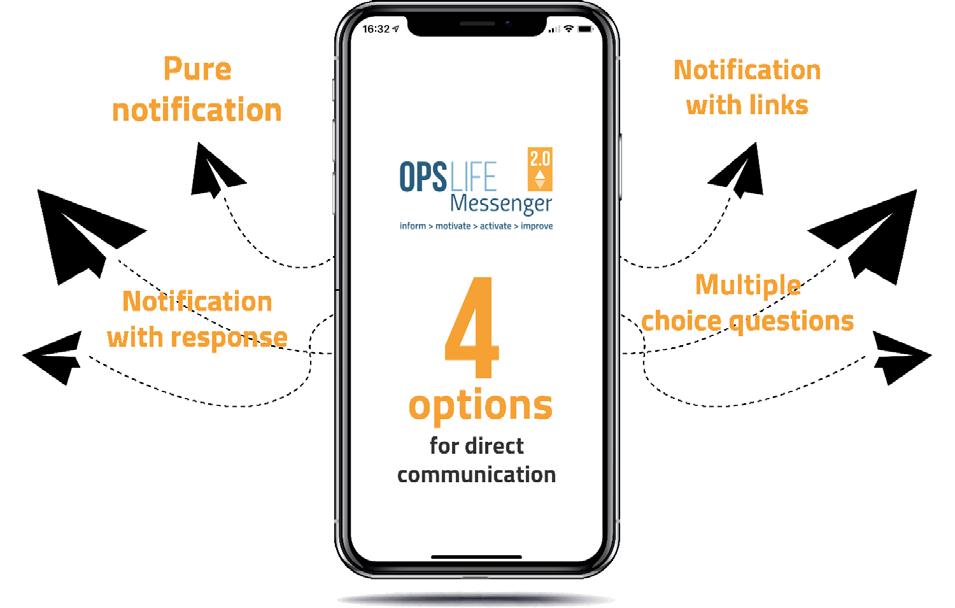
7 minute read
CONSTANT MOVEMENT
Generating and using energy in such a way that it doesn’t impact the environment has been pursued for many years, but this green future vision now seems more realistic than ever. While a number of sustainable forms of energy have proven successful and are being scaled up in capacity, other forms of energy are still in their infancy. This is the time to join forces, to apply and combine knowledge and expertise from different sectors. Together we are responsible and together we can make a difference. In terms of sustainability and in terms of HSEQ.
In 2020, wind produced the most renewable energy (733 GW) 1, after hydropower (1,211 GW). This meant a growth of wind energy of 111 GW2 in one year and it doesn't stop there! Especially China and the United States invested heavily and are responsible for almost 60% of the new installations3. But emerging regions such as Southeast Asia, Latin America and Africa are also going to play a bigger role. Given the developments we have seen in recent years and the plans in the pipeline, wind is an energy source that will bring us much more than it already does.
What exactly is wind energy?
Wind energy is generated with wind turbines. Wind turns the rotor blades and triggers a generator that converts the rotating motion into electricity. A transformer converts low voltage to medium or high voltage. Wind energy is generated worldwide by wind turbines on land and at sea. And those turbines seem to be getting bigger and bigger. Not surprisingly, because when a rotor diameter is doubled, the power output increases up to four times. And when the wind speed doubles, the power from wind is eight times greater4
The larger and more complex wind turbines and wind farms become, the more important a good safety culture is. This applies to the production and installation of wind turbines as well as to maintenance. Both onshore and offshore, because even in strong winds, for example, maintenance must be able to take place safely. "You can only achieve this if employees are alert and that requires maintenance of HSEQ knowledge and skills. Continuously keeping skills up-to-date by stimulating employees in an effective way and keeping them informed. This goes beyond just following periodic training courses," says Pier van Spronsen. Pier is founder of HSElife NL and HSEQ Direct, advanced systems that he and his team use to reduce workplace-related accidents worldwide. "It is necessary to create safer and more healthy workplaces. We owe that to ourselves, to the environment and to everyone around us."
Onshore vs offshore wind

Most wind energy is generated on land, but in the meantime great strides are also being made offshore. For example, in 2017 the first floating wind farm became operational off the coast of Scotland. The floating wind turbines are each held in place by three large suction anchors. There are now floating wind turbines in several places around the world. The advantage of placing offshore wind farms is that the wind at sea blows harder and more often than on land, which means that wind turbines at sea can generate more energy. On the other hand, it is currently still a lot cheaper to place wind turbines on land. In 2020, wind at sea provided 'only' 5% of the total wind power capacity, but that is changing rapidly...
Wind energy appears to be evolving
High-profile projects in the field of wind energy follow each other in rapid succession! Especially offshore, there is a lot going on.
For example, on the Dutch Maasvlakte is the Haliade X, the largest wind turbine in the world, with a height of 260 meters. The turbine delivered power for the first time in late 2019 and has a maximum capacity of 12 megawatts, while other turbines along the Dutch coastline have a maximum capacity of 2 megawatts. The Haliade X can generate enough power for approximately 16,000 households5. This flagship turbine, built by GE Renewable Energy, is also the starting point for projects in the United States and for a major project in the North Sea.

In February 2021, South Korea announced its intention to construct the largest offshore wind farm in the world6. The wind farm with 8.2 gigawatts of turbines is to be operational by 2030 and generates energy for 7% of South Korea's annual consumption. Currently, one-third of the electricity still comes from coal-fired power plants. With the arrival of the wind farm, South Korea will counteract the emission of approximately 30 megatonnes of CO2 annually. Hornsea 1 is currently the largest operational wind farm. It is located off the coast of Britain and has a capacity of 1.2 gigawatts. Until South Korea's announcement, IJmuiden Ver was the largest wind farm planned. This wind farm will be realized around 2025 off the coast of the Netherlands and accounts for 4 gigawatts.
Why choose wind energy?
Wind energy is a very clean form of energy that never runs out. In addition, the capacity of wind energy can still grow a lot. When producing, maintaining and dismantling wind turbines, CO2 is released. But after three to six months of operation, a turbine has already compensated for that amount of CO27. Over its lifetime, a wind turbine produces up to 80 times as much energy as it takes to build one.
Wind turbines produce 80 times as much energy as it takes to build one.
Health Effects
Opponents of wind farms regularly cite it as an argument: low-frequency noise from wind turbines cause health problems. There is still much uncertainty about these humming tones and vibrations. There are situations in which residents of wind farms experience stress and insomnia, for example. But whether this is really due to wind turbines? Scientists are ambivalent in their assessment.
The Dutch National Institute for Public Health and the Environment, commissioned by the Swiss Federal Environment Agency, listed all literature published on the topic between 2017 and mid-20208. This shows that annoyance occurs as a result of noise. The stronger the noise from wind turbines in dB, the greater the annoyance it causes. The literature did not show that low-frequency noise causes additional annoyance compared to ordinary noise. The research results about the health effects of wind turbine noise such as insomnia and cardiovascular disease are not unequivocal. What is striking, however, is that local residents experience less annoyance from wind turbines when they are involved in their placement.
Regulations on wind turbine placement
In countries such as Denmark, regulations are in place that stipulate that the distance from the wind turbine to be installed to the built-up area must be at least ten times the height of the turbine. So for a turbine of 150 meters high, a distance of 1,500 meters from the built-up area applies. This distance standard seems a good starting point, but these regulations are not yet in force everywhere.
In the Netherlands, for example, another five large wind turbines were placed less than 500 meters from twelve homes in 2019. The noise pollution from the turbines was so great that six of the twelve families have now moved. In an article of EenVandaag8 the story of Mr. Aan de Wiel can be read, he also moved because they could not bear the nuisance: "During that period I hardly slept for at least a month. It's like living right under an airport. Only the plane doesn't land or take off, it just keeps going." In the Netherlands, a noise limit that cannot be exceeded is being considered, which is 41 decibels. That seems to work for roads, for example, but not for a turbine that makes much more noise in high winds.
Safety culture in the wind power industry

Working in confined spaces, working at heights, working offshore, applying personal protective equipment, hoisting and lifting, working with electricity. Factors that entail risks and that professionals in the wind energy sector have to deal with. "Risks that need to be looked at seriously," believes Pier van Spronsen. "An accident can happen at any time. A moment's inattention or wanting to work too fast can be catastrophic, for example. It's not just about having the right certificates, training and experience. When you're in the wind energy business, you have to know that the safety and health of employees is the most important thing. You can't and shouldn't think too lightly about that. It has to be continuously top of mind, with everyone. A good safety culture can prevent dangerous situations and accidents. There are simply too many work-related accidents worldwide. I see it as our mission to use our 25 years of experience to reduce work-related accidents and create safer and more healthy workplaces. In all industries where employees work in a work environment where risks are on the horizon.”
Who can use wind energy?
Wind energy is one of the renewable energy forms that we can all benefit from. More and more households are supplied with 'green power' thanks to wind, but large companies can also run 100% on wind energy. It is also possible to install a small wind turbine at your own home, but this is not always interesting. If no subsidy applies for installing a small wind turbine, it is not attractive from a financial point of view. Even in optimal conditions, you will not recoup your money before the life span has expired. Of course, installing a wind turbine can also be a choice to minimize your impact on the environment.
We assist you with these tools & services for a safer and healthier workplace!
OPSLIFE MESSENGER 2.0 is a TWO WAY COMMUNICATION SYSTEM which enables your company to keep your employees ALERT, MOTIVATE them to participate, ACTIVATE them to think and contribute towards achieving the company’s goals and to IMPROVE their work processes, safety and company culture ... ON-DEMAND!

Besides the OPSlife Messenger communication tool, with the use of all other integral tools and services of HSEQ Direct, such as Full HSEQ library, Virtual training modules, Action Focus campaigns, Maintaining knowledge app and Learning and Registration System, your company can create a safer and healthier workplace.
For more information about HSEQ Direct visit our informational website.






